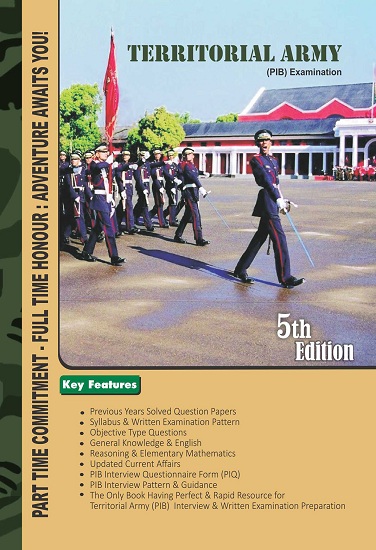The wait is finally over as the Indian army has released the Territorial army syllabus. All the candidates who had registered and have been aspiring to join can take a breath of relief as now the syllabus is out.
Territorial Army Syllabus
The Territorial army Syllabus And Exam Pattern are out. There have been many candidates who have been asking about the syllabus and the exam pattern. To solve all the queries of the candidates regarding the territorial army written exam and preparation we have curated a properly structured plan for the same.

Check Out 5th Edition Territorial Army PIB Examination Book: Click Here
Exam Pattern
There are two subject papers, one is paper 1 which is of 2 hours and the other is paper 2 which is also for 2 hours. The further division is as follows:
The structure of The Written Exam Paper one is as follows:
- Part 1: Reasoning, which has 50 questions and each question carries one mark each.
- Part 2: Elementary Mathematics, which also has 50 questions and each question carries one mark each.
The structure of the Written Exam Paper two is as follows:
- Part 1: General Knowledge, which has 50 questions and each question carries one mark each.
- Part 2: English, which has 50 questions and each question carries one mark each.
Once, the candidates have understood the pattern of the exam properly, the next step is to properly understand the syllabus. Before starting to prepare for any exam, it becomes very important to know the territorial army syllabus to avoid wastage of time and efforts. Once the syllabus is known, then the candidates and the students can put in their efforts in the right direction.
Also Check: Territorial Army Bharti Notification
Territorial Army Subject Wise Syllabus Details
Paper 1: Reasoning and Elementary Mathematics
- Reasoning:
As the subject says, the reasoning is all about checking the candidate’s problem solving and reasoning skills. The question paper which is designed by the institution is designed in a very thoughtful manner which covers all the important aspects to check. The question paper is designed in a manner which can help to check the candidate’s ability and skills which can complete the sequences to make the logical conclusions. These logical conclusions are primarily based on various patterns numbers, statements, figures, letters etc. The candidates are expected to show proper rational thinking under various circumstances.
- Elementary Mathematics:
Arithmetic Maths:
- Number System: The topic number system includes various sub-topics such as natural numbers, integers, rational and real numbers. Fundamental operations – addition, subtraction, multiplication, division, square roots, decimal fraction.
- Unitary Method: The topic Unitary Method includes various sub-topics such as Time and distance, time and work, percentages, application to simple and compound interest, profit and loss, ratio and proportion, variation.
- Elementary Number Theory: The topic Elementary Number Theory includes various sub-topics such as Tests of divisibility by 2, 3, 4, 5, 9 & 11. Multiples and factors, factorization theorem, HCF and LCM. Euclidean algorithm, logarithms to base 10, laws of logarithms, use of logarithmic tables.
- Algebra: The topic Algebra includes Basic operations, simple factors, remainder theorem, HCF, LCM, a theory of polynomials, solutions of quadratic equations, the relation between its roots and coefficients (only real roots to be considered). Simultaneous linear equations in two unknowns-analytical and graphical solutions. Simultaneous linear equations in two variables and their solutions. Practical problems leading to two simultaneous linear equations or inequations in two variables or quadratic equations in one variable and their solutions. Set language and set notation, Rational expressions, and conditional identities, laws of indices
- Trigonometry: The topic Trigonometry includes Sine x, cosine x, tangent x when O° < x < 90°. Values of sine x, cos x and tan x, for x = 0°, 30°, 45°, 60° & 90°. Simple trigonometric identities. Use of trigonometric tables. Simple cases of heights and distances.
- Geometry: The topic Geometry includes Lines and angles, Plane and plane figures theorems.
Paper 2: General Knowledge and English
- General Knowledge
The candidate is supposed to be very well versed with all the topics of general knowledge. GK is broadly divided into two main headings, one is the current affair and the other is the static GK. Candidates are supposed to be aware of both current and static GK. The paper is made in such a manner which includes knowledge from all spheres of life such as technology, business, politics, education etc. The paper also includes historical data as well as questions on geometry which the candidates are expected to be aware of. GK is also helpful in the territorial army interview.
- English:
The question paper is made to check the basic language skills of the candidates which include all the grammar rules as well. The major questions from the English paper are from synonyms, antonyms, reading comprehension, Para jumbles, error spotting, jumbled sentences, sentence correction and fill in the blanks.
